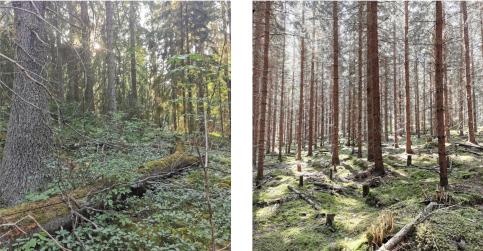Background & Aim

Commercial exploitation of forests has today resulted in monocultural, young, and relatively dense forests. Today, around 55 % of the global forests are managed as production forests. In Sweden, almost all woodland has gone from natural forests to coniferous production forests during the last 150 years. In total, 69 % of Sweden’s land surface consists of forest land, of which only 12.5 % is older than 140 years, and only 8.7 % is under formal protection.
The transition from natural forests to monocultural production forests has had a large impact on forest ecosystems' structure and function. They differ from each other structurally in terms of tree species, canopy structure, forest cover continuity, age class distribution, and vertical vegetation. Consequently, the transition from natural to production forests has led to the decline of many forest-associated species.
Invertebrates, wood-inhabiting fungi, and bryophytes are some of the groups affected by the transition. Insect populations suffer globally, and recently there have been reports of a massive decline of insect biomass with up to 75 %. Dead wood tends to decrease in forests managed as production forests. However, In Sweden, over 6000 species are depending on dead wood, including moss and fungi species.
Aim
In this study, I aimed to compare productions forests of different ages with natural forests with a focus on three comparisons;
- Insect biomass of flying insects
- Dead wood quantity and quality
- Wood-inhabiting moss and fungi species
Responsible for this page:
Director of undergraduate studies Biology
Last updated:
05/28/21
